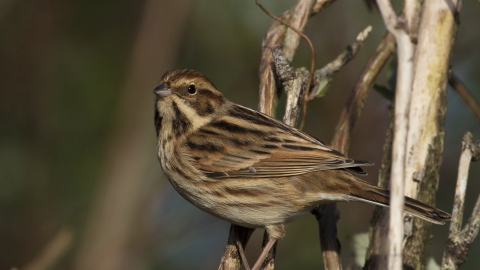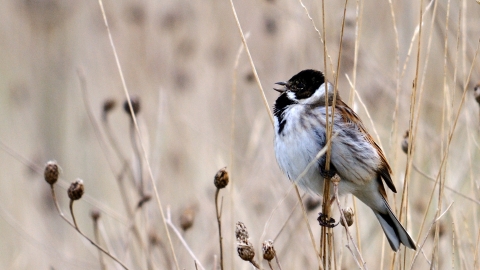
©Chris Lawrence

©Amy Lewis
Reed bunting
Scientific name: Emberiza schoeniclus
A streaky brown bird, the reed bunting can be found in wetlands, reedbeds and on farmland across the UK. Males sport black heads and a white 'moustache'.
Species information
Category
Statistics
Length: 16cmWingspan: 24cm
Weight: 21g
Average lifespan: 3 years
Conservation status
Classified in the UK as Amber under the Birds of Conservation Concern 5: the Red List for Birds (2021). Protected in the UK under the Wildlife and Countryside Act, 1981. Priority Species under the UK Post-2010 Biodiversity Framework.
When to see
January to DecemberAbout
A sparrow-sized bird of reedbeds, wetlands and farmland, the reed bunting feeds on seeds and invertebrates. In the winter, reed buntings join mixed flocks of buntings, finches and sparrows to feed on seeds on farmland. During the breeding season, males can be spotted perched high on reeds, rushes or scrub, voicing their simple, three-note territorial call. Females breed low in the dense vegetation, constructing their nests from grass, reeds and moss. If a predator comes close, it may be drawn away by one of the adults acting as if injured.How to identify
The reed bunting is a streaky brown bird. In summer, the males have black heads and black throats extending down into a bib, with a white collar and white 'moustache'. In winter the head is mostly brown, though the white collar and 'moustache' are still obvious. The throat becomes pale, though there are usually traces of the dark bib still visible.Female buntings, including female yellowhammers and reed buntings, can be very difficult to tell apart. Female reed buntings have a pale throat and 'moustache', separated by a dark streak that reaches the base of the beak. They lack the yellowish hues of a female yellowhammer.
Distribution
Widespread.Habitats
Did you know?
Reed buntings will sometimes visit garden birdtables, especially in cold winters.Watch
Reed Bunting by John Bridges
